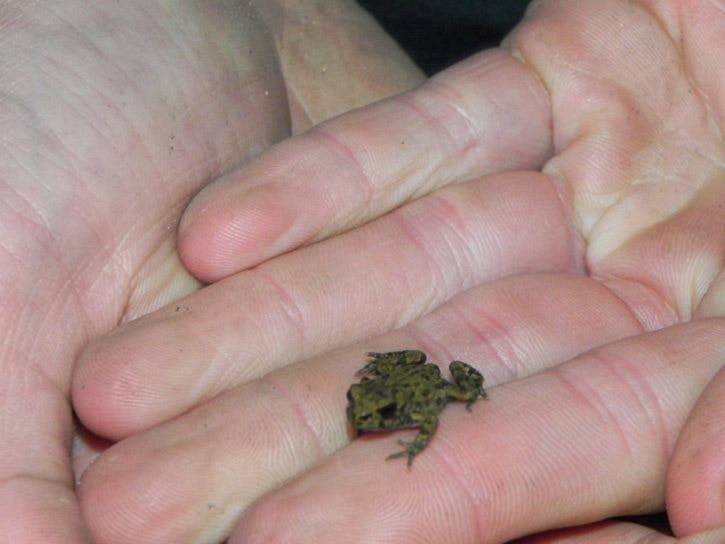The ground at the Kawkawa Lake picnic area and boat launch is hopping with tiny, dark coloured toads this time of year, but residents say that’s nothing out of the ordinary.
“I’ve lived here my whole life,” Laurel Loring said Monday. “And there’s always been tadpoles and toads here.”
Loring, along with a group of other parents, spent the day cooling off at the beach with her three children. The kids squealed with delight as they found wildlife in the water, and out. The tiny toads range in size from a dime to a quarter, and hop close to the shoreline.
The toads used to hang out more toward the picnic area than the main beach, Loring said. But they’re now finding their way onto the beach, and over the last two weeks have been observed hopping around the boat launch.
Biologist Mike Pearson said they are actually toadlets, migrating out of the water where they lived as tadpoles. They are leaving their warm, watery home and moving up into the bushes around the park. And yes, he added, they are the same toadlets that caused a media frenzy in Ryder Lake near Chilliwack recently. There, roads had to be closed to allow for the proper migration of toadlets from a pond to the forest.
Warm waters are the perfect habitat for the Western toad, Lisa Fox, executive director of the Fraser Valley Conservancy said. The Conservancy has been helping the blue-listed toads’ migration at Ryder Lake for the past four years. Both the Conservancy and Pearson were not aware that Western toads had habitat in that area of Kawkawa Lake.
But Pearson said it’s not surprising to find them, as the toads are very common around the province. What’s also becoming common, however, is urbanization of previously forested areas. In short, people are moving into their habitat.
“There’s been this long-term decline in numbers,” he said, and while they’re a listed species, they are listed at the lowest level possible. Under the DFO’s Species at Risk Act, they’re listed as special concern, and at the provincial level, they’re blue-listed.
What that means is the government agencies keeping track of wildlife numbers want to know where these animals are living. Pearson, whose company Pearson Biological sometimes works in conjunction with the DFO, wasn’t sure if the area was already mapped as a Western toad migration area, but as a result of photographs and conversations with this newspaper, has sent in a report of local observations.
He said the presence of a blue-listed species like the Western toad shouldn’t be troublesome for a municipality.
“The ministry just needs to know when people see these things,” he said, to keep track of the numbers to know the true situation for each species.
People should feel free to call either the Ministry of Environment, DFO or the Fraser Valley Conservancy if they see a listed species. Even if the location is a known one, environmental workers can map the timing of events such as egg laying, hatching and migration.
The Conservancy is making advances in finding innovative ways to allow the toads to cross the road at Ryder Lake, Pearson said. And if that’s successful, he said it could be possible to help toads in other situations. As it stands, the traffic at the boat launch, and human foot traffic could be a concern for the toads. However, before the toadlets make it to dry land, they’ve already been predated by larger animals in the water.
Maurice Wutzke, Director of Operations for the District of Hope, said it’s a well-known fact that toads enjoy living in Kawkawa Lake.
“They thrive there,” he said, but residents will see less and less of the toads as the nights, and the water, begins to cool down.
To report a listed species sighting, phone the Fraser Valley Conservancy at 604-850 -7733.
